|
The Lamborghini
Miura Concept has made its public debut at the North
American International Auto Show, the 'retro' styled Walter
de'Silva design drawing unashamedly on the original 1960s
icon.
Updated for the 21st Century the Miura Concept has instantly polarised
opinion, some arguing that the new project carefully updates and
improves what is arguably the most beautiful sportscar ever
built, while others are horrified that Lamborghini have
stepped back four decades when reaching for design
inspiration. 'Retro' has certainly been a big theme at the
Detroit Auto Show this January with the brash, muscular new
Dodge Charger being one of the loudest stars of the whole
event.
“Over the last two years,” explains Walter de’Silva, “I have
often dreamt of redesigning the Miura. Now, thanks to my new
position at the head of Lamborghini design and the
enthusiastic support of the Lamborghini CEO, Stephan Winkelmann, I have been able to
turn that dream into a reality.” Carefully retaining the
gorgeous shape of the original Miura, and distinct features
such as the recessed headlamps with their individual
eyebrows, the rear window louvres and the B-pillar, de'Silva
has updated the surfaces and finish.
In the meantime Lamborghini are remaining very tight lipped
as to whether this concept could get the green light for
limited production. However talk has centred on a production
version using the Gallardo's chassis, the Murcielago's
6.2-litre V12 mid-mounted to keep true to the original Miura
coupled to the highly-regarded 7-speed 'Double Shift
Gearbox' used by the Bugatti Veyron, which is also a member
of the VW-Audi Group. Speculation has centred on a build run
of up to 400 units with a US$675,000 Ferrari Enzo bracket
price tag being mentioned.
Lamborghini Miura 1966-72
The Miura grew out of the
desire of Dallara, Wallace and Stanzani (the main designers
at Lamborghini) to go racing. They developed a new chassis
with a mid-mounted transverse engine in the hope of
persuading Lamborghini to race it. That attempt failed, but
the chassis was displayed on the Lamborghini stand at the
1965 Turin Motorshow and Lamborghini asked Bertone to design
a body for it to use as a show car. The design
work was carried out by Gandini and Giugiaro (both at
Bertone) and revealed to the world at the Geneva Motorshow
in 1966. Although having had no plans to produce it,
Lamborghini took 17 deposits at the show and so production
was go.
|
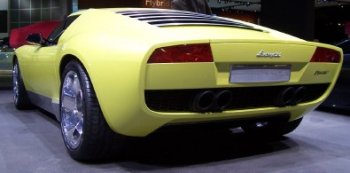
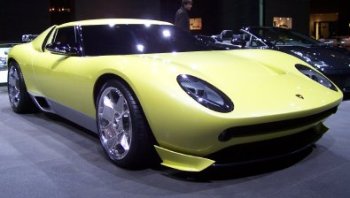
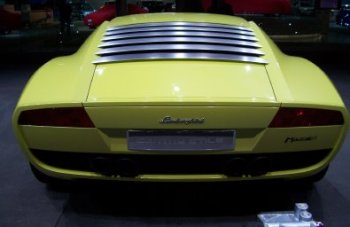 |
|
Updated for the 21st Century the Miura Concept has
polarised opinion, some arguing that the new project
updates and improves what is arguably the most
beautiful sportscar ever built, while others are
horrified that Lamborghini have stepped back four
decades when reaching for design inspiration.
Photos: Jalopnik. |
|
|
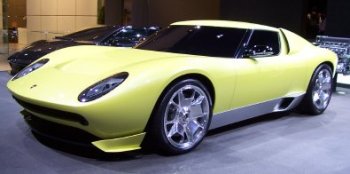
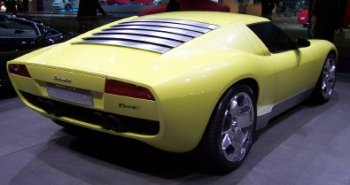
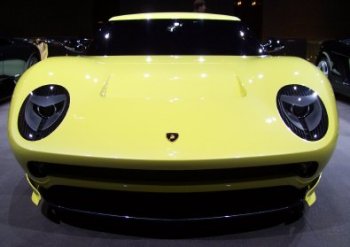 |
|
The Lamborghini Miura Concept has made its public
debut at the North American International Auto Show
this week, the 'retro' styled Walter de'Silva design
drawing unashamedly on the original 1960s icon.
Photos: Jalopnik. |
|
|
Significant development was
again necessary to turn a basic race car into a road car,
the main problems being the heat and noise of the engine,
being mounted directly behind the occupants heads. The
wheelbase was increased slightly, a vertical rear window
(double glazed) and lots of insulation inserted behind the
occupants, a slatted cover replaced the window over the
engine, extra air ducts forced air around the engine and and
the front radiators were mounted vertically.
When the
car entered production, it used a chassis comprising a
central section, including the floor, given strength by the
large sills and centre tunnel, and extensions front and rear
for the suspension and engine and suspension respectively.
The engine was basically a 400GTV unit, with the same
vertical carburettors and 350bhp. A Sprint verion was also
available with (a claimed) 430bhp - probably nearer 380. The
main difference was that the transmission housing was cast
together with the crankcase, the gears being housed below
the engine in the sump. The steering adopted a
rack-and-pinion layout. The interior of the Miura reverted
to the more traditional lower bracket Italian style, rather
than the plush trim of previous Lamborghinis.
The
Brussels Show of 1968 saw Bertone reveal a spider version,
the Roadster, but nothing came of that project. In 1968
changes to the production model included more power (up to
370bhp), a larger boot (due to a revised exhaust system),
new seats and a slightly improved interior, chrome trim
around the windows and headlights and electric windows as
standard. In this form the car became known as the Miura S.
This continued in production until 1971 when the Miura SV
was revealed. Using many of the features improved in the
Jota (see below) the SV had 385bhp, a strengthened rear
chassis, wider wheels and larger tyres, some suspension
modifications and a variety of detail changes such as the
loss of the 'eyebrows' over the headlights, new secondary
front lighting and revesing lights at the rear. The most
significant change was the new engine where the sump and
gearbox were finally separated, allowing different oils to
be used, but the brakes also got ventilated discs (as had
the last S versions).
Photos courtesy of
Jalopnik
|
|
|
|
![]()
![]()